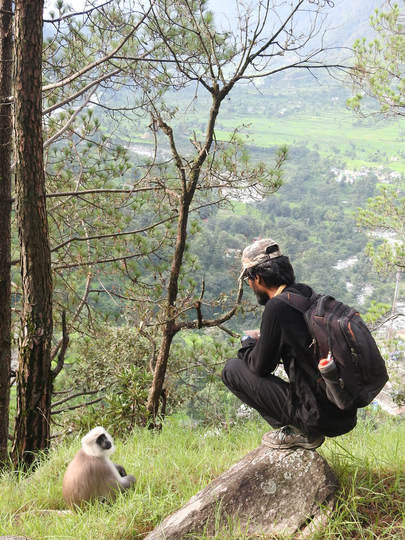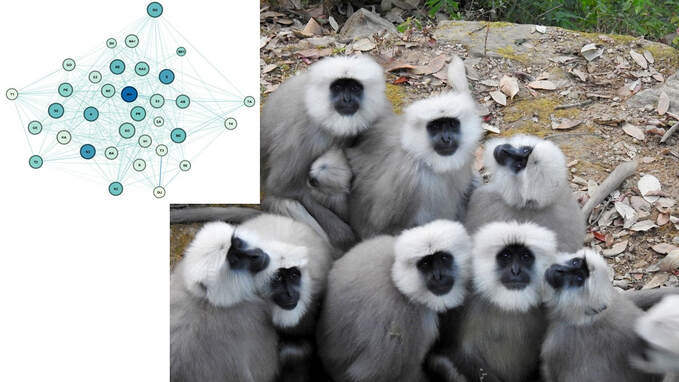Explore research and community-engagement driven conservation methodology for Chamba Sacred Langur (Semnopithecus ajax)
|
This project was carried out in Kugti Wildlife Sanctuary, located in the northwestern part of Himachal Pradesh in a narrow temperate and alpine climate zone belt. The aim of the project was to collect preliminary data on the ranging and foraging behavior of S. ajax using systematic observational methods which will help to fill a gap in the data availability from the Indian Himalayan Region (IHR) for the langur populations. This will help to compare the ecology of langur populations across the IHR with studies that were conducted in Uttarakhand and Jammu and Kashmir. Another aim of this project was to understand the perception of locals of Kugti village, as it is the only village that shares the range with langurs, towards their interaction with them. We administered a questionnaire survey to gather data on the socio-economic and demographic variables, and gathered their response to open-ended questions about their perception of langurs. The villagers here practice subsistence agriculture and grow apple to add to their earnings. The overall production is low in these high-altitude mountainous habitats, and thus crop-foraging by langurs (and other big herbivores, like brown bear) negatively affect the perception of villagers towards the wildlife. The forest around the village also serves as an important resource for wood and fodder for the villagers, but increasing pressure on these forests could lead to fragmentation and reduction in suitable habitat foe langurs. These interacting factors will be affected by changing weather patterns and thus it becomes important to build scientific evidence to address any viable conservation policies aimed towards habitat protection for langurs in the high-altitude areas.
|
Principal investigator: Virendra Mathur, Msc, Indian Institute of Science Education and Research (IISER) Mohali, India
Scientific advisor: Dr. Himani Nautiyal |
Hunting and cultural practices by Apatani Tribe of Eastern HimalayaPrincipal investigator: Takhe Bamin, Msc Wildlife Management "National Geographic Explorer"
Scientific advisor: Dr. Himani Nautiyal |
Conserving wildlife within the remaining forest fragments will depend upon our understanding of the impact of hunting in fragment habitats and developing appropriate management strategies. The current hunting situation has both a direct and indirect impact on the community structure, and if left unmanaged, could cause an irreversible impact on the ecosystem. To counter this, it is very important to initiate studies investigating the community and surrounding forests, in order to understand and quantify wildlife hunting pressure which will provide the proper data to introduce any further research and conservation actions which are vital for biodiversity and the local community.
|
Sleeping site preference in a group of Central Himalayan Langur |
| ||||||

Principal investigator: Virendra Mathur, IISER Mohali
Supervisors: Dr. Himani Nautiyal & Dr. N.G. Prasad
The objective of this study is to understand the sleeping site preference in a habituated population of Central Himalayan Langur (Semnopithecus schistaceus) and understand the choice of sleeping tree species fashioned by the change in weather conditions, from wet to dry during the months of August to December, as well as other ecological constraints like parasite avoidance, predation avoidance, and social dynamics. Such a study shall provide the necessary insight into exploring the socio-ecology of the virtually unknown Central Himalayan Langur species. Virendra Mathur, a final year Masters student at Indian Institute of Science Education and Research (IISER), Mohali, will be undertaking the above said study as a part of his masters dissertation thesis work.
Supervisors: Dr. Himani Nautiyal & Dr. N.G. Prasad
The objective of this study is to understand the sleeping site preference in a habituated population of Central Himalayan Langur (Semnopithecus schistaceus) and understand the choice of sleeping tree species fashioned by the change in weather conditions, from wet to dry during the months of August to December, as well as other ecological constraints like parasite avoidance, predation avoidance, and social dynamics. Such a study shall provide the necessary insight into exploring the socio-ecology of the virtually unknown Central Himalayan Langur species. Virendra Mathur, a final year Masters student at Indian Institute of Science Education and Research (IISER), Mohali, will be undertaking the above said study as a part of his masters dissertation thesis work.


